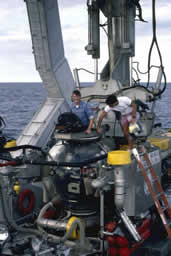Scientists prepare to explore mysteries of rocky feature off Charleston's coast
BY LYNNE LANGLEY
Of The Post and Courier Staff
Anglers and commercial fishermen know the Charleston Bump for the fish they catch above it, fish that may also spawn on the rocky rise that deflects the Gulf Stream and even affects the weather. Photo provided by SCDNR

Charlie Barans prepares to enter the Johnson-Sea-Link submersible for a dive last summer.
At what they call "Oh-dark-30," or shortly before dawn today, local marine scientists will leave Charleston for a 13-day voyage to explore the bump itself. They will descend some 2,000 feet into the dark realm with lights, cameras and special equipment to capture sights humans will be seeing for the first time.
"We're quite sure we will discover new species," said George Sedberry, principal investigator of the national Ocean Exploration cruise to the Charleston Bump.
"It's going to be fun and exciting," said Charleston marine scientist Elizabeth Wenner. "It's a whole other world when you descend to those depths."
Crabs, starfish and other creatures are brilliant oranges, reds and purples. Red creatures remain invisible until a deep-sea submersible sheds light in the darkness, she said.
This marks the third summer that the federal Office of Ocean Exploration has chosen projects to discover secrets of the planet's last frontier, including hydrothermal vents where strange creatures and plants thrive in toxic conditions, the sunken Civil War ironclad Monitor, active volcanoes, seafloor methane seeps, potential medical cures and sources of energy.
Sedberry was aboard the first year when a national Islands in the Stream voyage made a brief stop at the Charleston Bump and saw just enough that the federal ocean folks wanted to learn more.
This time, scientists will spend 11 days looking into nooks, crannies, caves, and coral mounds in the bump, said Sedberry, a senior marine scientist with the S.C. Department of Natural Resources.
"This is discovery and exploration," he said. Even though the Charleston Bump is only 70 to 80 miles from land, he said, "With the rough bottom, the currents and the depth, it has not been explored."
Strong currents are thought to bring food to the bump and distribute eggs and larvae spawned there. The bump juts up so high that it deflects the Gulf Stream to the east. "It affects the whole oceanography of the region," Sedberry said.
As chief scientist on the cruise, Charlie Barans is carefully planning each dive in the deep-sea submersible Johnson-Sea-Link and trying to ensure every scientist gets at least one chance to observe and sample. He also counts on surprises.
"You've got to be flexible when you're doing exploration. We're always anxious to document rare events," said Barans, also a DNR senior marine scientist.
The 17 scientists, nearly all from South Carolina institutions, will be looking for creatures that have evolved ways to live in the fast currents around the bump, Barans said. Suction devices, the sub's manipulator arms and a 400-pound pipe dredge, developed by DNR staff, will collect samples of animals, plants and rocks.
Some samples will be kept in Charleston at the new Southeastern Regional Taxonomic Center, which Wenner directs. Here, new species will be described to science and what are called voucher specimens will be stored in a museum. Otherwise, as the coast develops, species might be lost before they are ever discovered, she said.
Each morning some of the scientists will squeeze into an acrylic sphere about 4 feet in diameter for a dive that begins in a mix of fear and anticipation, Barans said. "Then you see things that supercede the fear. Once you are on the bottom, it is like being on the moon."
After three hours, when the batteries run low, the research vessel retrieves the submersible, bouncing around in the waves and often making everyone extremely seasick. The divers share their experiences before another group makes the afternoon dive.
At night, from the sea surface, plankton tows will collect fish eggs, larvae and other tiny life, providing evidence of what important fish may spawn at the bump including swordfish, marlin, tuna and wreckfish.
Sedberry hopes to learn more about wreckfish, which commercial fishermen began taking in the late 1980s. Efforts are under way to manage the species before it is over-fished.
In fact the Charleston Bump is closed to wreckfish fishing during spawning season, Jan. 15 to April 15, when swordfish and billfish also might be spawning there, Sedberry explained. Plankton tows on this expedition will check larvae, which could confirm spawning seasons and help refine closures on the bump, he pointed out.
By day, adult blue and white marlin, sailfish and swordfish will be temporarily caught and given high-tech tags that will feed information on their movements and migration to a satellite and then to Sedberry's office in Charleston.
In between all the sub and shipboard activity, scientists will post reports on a Web site for people and classes around the world to read. The site is designed to translate science to the public, explained Paula Keener-Chavis, national education coordinator with the Office of Ocean Exploration.
Stationed in Charleston, she spent Wednesday working with 24 teachers from around the Southeast whose classes have signed up to follow the voyage as Ocean Exploration Schools of Discovery.
"This is a wonderfully engaging way to start school. It's a way for teachers to hook students and get them engaged," she said.
The Web site, which includes three years of Ocean Exploration voyages, has hits from more than 100 countries ranging from Australia to Romania to India.
The Charleston Bump cruise will
end in Charleston Aug. 14, and participating classes will get to tour
the boat and meet the scientists, she said.